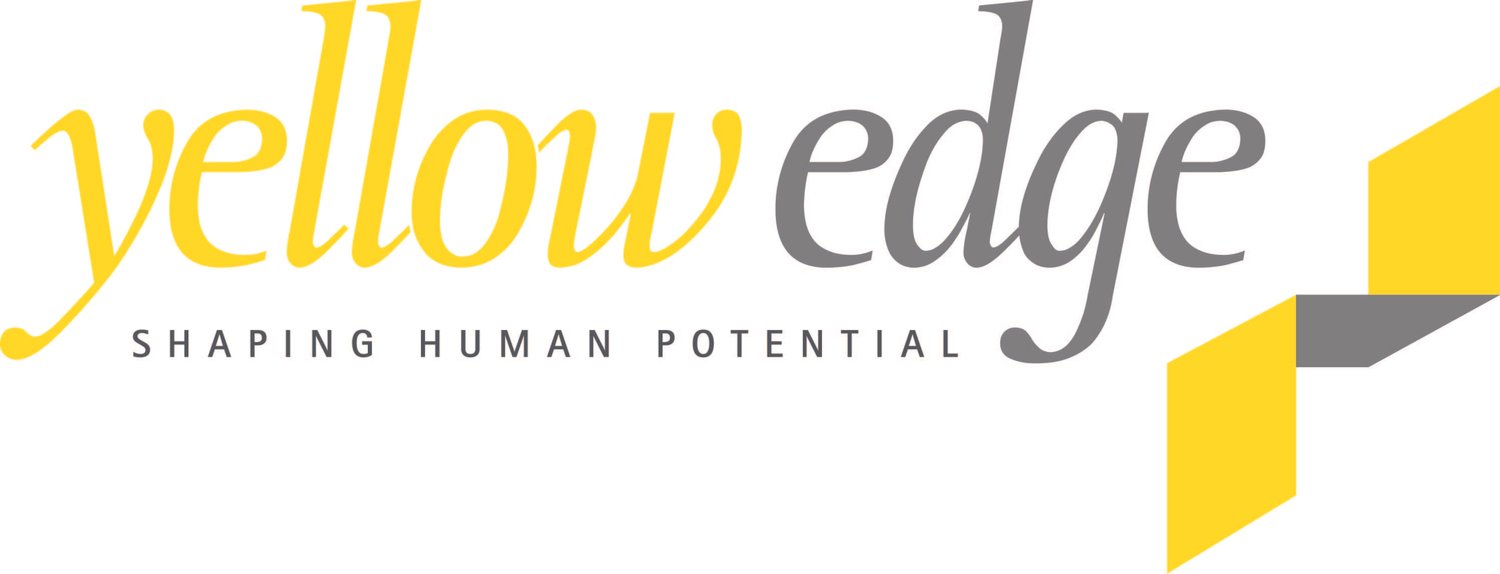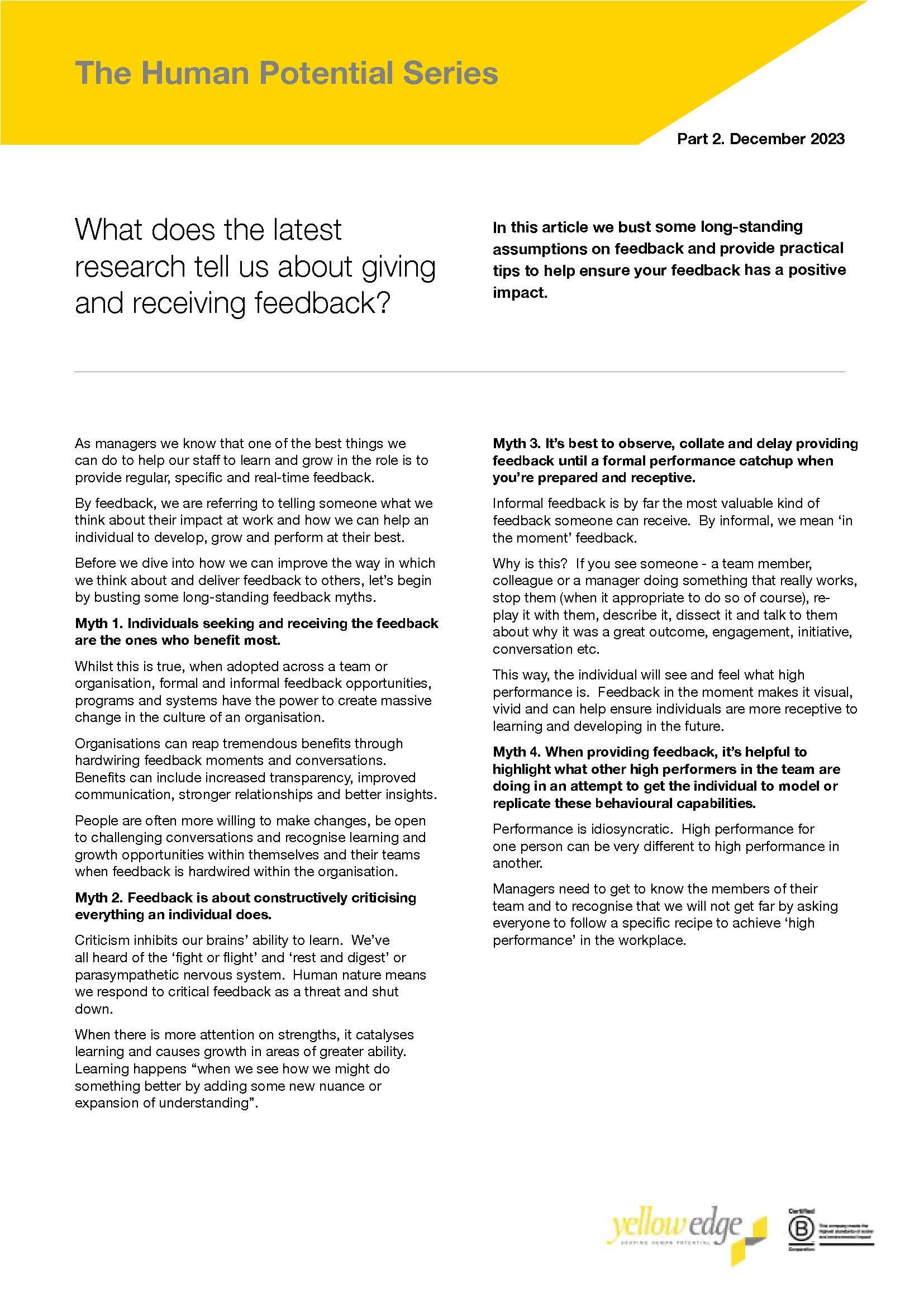64. What Does the Latest Research Tell Us About Giving Feedback?
by Brooke Anderson
In this article we bust some long-standing assumptions on feedback and provide practical tips to help ensure your feedback has a positive impact.
As managers we know that one of the best things we can do to help our staff to learn and grow in the role is to provide regular, specific and real-time feedback.
By feedback, we are referring to telling someone what we think about their impact at work and how we can help an individual to develop, grow and perform at their best.
Before we dive into how we can improve the way in which we think about and deliver feedback to others, let’s begin by busting some long-standing feedback myths.
1. Individuals seeking and receiving the feedback are the ones who benefit most.
Whilst this is true, when adopted across a team or organisation, formal and informal feedback opportunities, programs and systems have the power to create massive change in the culture of an organisation.
Organisations can reap tremendous benefits through hardwiring feedback moments and conversations. Benefits can include increased transparency, improved communication, stronger relationships and better insights. People are often more willing to make changes, be open to challenging conversations and recognise learning and growth opportunities within themselves and their teams when feedback is hardwired within the organisation
2. Feedback is about constructively criticising everything an individual does.
Criticism inhibits our brains’ ability to learn. We’ve all heard of the ‘fight or flight’ and ‘rest and digest’ or parasympathetic nervous system. Human nature means we respond to critical feedback as a threat and shut down.
When there is more attention on strengths, it catalyses learning and causes growth in areas of greater ability. Learning happens “when we see how we might do something better by adding some new nuance or expansion of understanding”.
3. It’s best to observe, collate and hold back providing feedback until a formal performance catchup until you’re prepared and receptive.
Informal feedback is by far the most valuable kind of feedback someone can receive. By informal, we mean ‘in the moment’ feedback.
Why is this? If you see someone - a team member, colleague or a manager doing something that really works, stop them (when it appropriate to do so of course), re-play it with them, describe it, dissect it and talk to them about why it was a great outcome, engagement, initiative, conversation etc.
This way, the individual will see and feel what high performance is. Feedback in the moment makes it visual, vivid and can help ensure individuals are more receptive to learning and developing.
4. When providing feedback, it’s helpful to highlight what other high performers in the team are doing in an attempt to get the individual to model or replicate these behavioural capabilities.
Performance is idiosyncratic. High performance for one person can be very different to high performance in another.
Managers need to get to know the members of their team and to recognise that we will not get far by asking everyone to follow a specific recipe to achieve ‘high performance’ in the workplace.
____________________
Next time you’re about to provide feedback to a staff member, a colleague or a manager remember these three things.
1. Focus on your instinctive reactions and experiences.
Focus on articulating your direct observations, experiences and feelings.
As Andrew Simon, co-CEO of Yellow Edge describes it, “include succinct narrative accounts of the individual’s performance that highlight the richness, nuance and impact in a way that equips them with learnings and experiences that can be applied for future performance use.”
For example, what did you experience or feel when the individual in question delivered, led, managed, or acted? The closer you provide this feedback to the occasion the better. It crystallises the moment and helps make the situation more vivid for the individual receiving the feedback.
2. Focus on strengths.
We are much more likely to learn, grow and perform at our best when we recognise, reinforce and refine what is already there.
More often than not we know our weaknesses. Drawing attention to short-comings or blind spots can be helpful if the feedback is designed and framed in terms of how to help someone prevent their weaknesses becoming a derailer or how to mask a weakness by leveraging a strength.
3. Focus on outcomes.
The research is clear – telling people what we think of their performance and how we think they can improve is not as helpful as some of us would think.
We need to take into consideration what high performance looks like to that individual. It won’t be the same as their team members.
Try to understand their unique patterns of being and behaviour and how it can be re-created and anchored in the every-day. Thinking about their impact at work and the outcomes that they achieve is great place to start.
_______________
And what if you’re asking someone for feedback?
1. Cast the net wide
Eliciting feedback from just one person, be it your manger or your direct report, will only ever tell you what that one person thinks about you.
Think about the work you do and the various stakeholders both within and outside the organisation who have sufficient exposure and experience of working with you. This may include colleagues from task forces, intergovernmental committees, contractors, suppliers etc.
2. Share why the feedback is important to you.
Providing more context as to why you’re seeking feedback can help those providing feedback focus in on the areas which you’re most interested in. Does it relate to a specific incident, project, relationship or is it in relation to a capability you’ve been working on.
To strengthen relationships and build trust with your team and those you work with, talk to them about why feedback is important to you and how you intend to take it on board.
3. Time the request for feedback.
Think about a range of individual, team and organisational ‘triggers’ for conversations in the workplace.
Feedback can be sought immediately before or after a project start up or consolidation meeting, in advance of a budget allocation meeting, to coincide with the appointment of a new Divisional Head or during the development of a business plan.
There are many workplace opportunities both routine and at key stages in the business planning cycle in which to seek out meaningful feedback.
Published December 2023
Brooke Anderson is Head of Research, Sustainability and Social Impact at Yellow Edge, a leadership development company focused on shaping human potential.
Yellow Edge is a local, privately owned Canberra based consulting company focused on helping individuals, teams and organisations to achieve high performance. Yellow Edge is a certified BCorp. BCorp companies make decisions that make a positive impact on their employees, customers, suppliers, community, and the environment. https://www.bcorporation.com.au/


